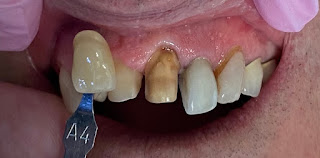Should the material a crown is made from dictate the amount of reduction?
Traditionally dentists have been trained to provide a chamfer or shoulder of 1 mm if possible. For smaller teeth .75 mm might have been used in order to not overly weaken the remaining tooth structure. This amount of reduction was advisable because most of the crowns made were porcelain fused to metal crowns that needed this reduction to make room for both metal and porcelain materials.
With the advent of adhesive dentistry, some dentists (myself included) used more minimal reduction strategies for anterior teeth. After all, only a .5 mm chamfer or shoulder is necessary to fabricate bonded feldspathic crowns. More reduction was needed where the restoration would be in occlusion, but at the neck of the prep restorative material is not under as much stress and shouldn't need as much thickness.While esthetics can sometimes dictate a greater reduction (especially in the case of a darker stump shade), most of the time .5-.75 reduction is all that is necessary.
Another consideration is whether the preparation will need to be extended to the root surface of the tooth. This often happens with older patients who have experienced more gingival recession. Heavier reduction (1mm+) at the neck of these teeth can make them more likely that either the remaining tooth structure will be weakened or worse, may increase the likelihood of a future root canal.
The good news is that our newer cad cam all ceramic restorations probably do not require as much gingival reduction. Millable zirconium restorations only require .5 mm thickness and their margins can even be polished to be thinner by use of a zirconium polishing wheel after their fabrication. I believe that a polished margin can be made considerably thinner, which is needed when a 45 degree chamfer preparation is utilized. In my practice I routinely use this finish line and often thin my zirconium crown margins, after their fabrication, to improve my crowns emergence profile.
Lithium disilicate crowns also only need a ,5 mm gingival chamfer thickness if they are monolithic. If a porcelain overlay is used probably its best to provide an additional .25 mm of reduction ( total .75 mm).
As I pointed out because these newer restorations allow more tooth conservative preparations, probably they will help both lessen the likelihood of need for a future root canal as well as a subsequent tooth fracture. For both of these reasons dentists should consider using the more tooth conservative preparations these materials allow when preparing their patient's teeth.
from Ask Dr. Spindel - http://lspindelnycdds.blogspot.com/2021/07/should-material-crown-is-made-from.html - http://lspindelnycdds.blogspot.com/


Comments
Post a Comment